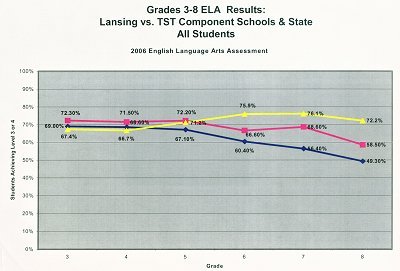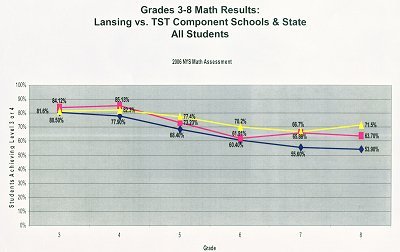- By Dan Veaner
- Around Town
 Print
Print
Lansing School Superintendent Mark Lewis presented the results of the 2006 English/Language Arts (ELA) and Mathematics testing at the Board of Education meeting last week. The results were generally good, but mixed, with 3rd and 4th Grade scores below New York State and Tompkins County, and Grades 5 through 8 matching or exceeding them. But Lewis says he sees this data as an opportunity for the district to improve. "We will share this data with teachers to initiate a dialog about how to use this data in the most effective way," he said.
In fact, he illustrated how detailed the data is, and how he plans to use it as a stepping stone for improving performance where needed. Using a test question based on a Tolstoy passage that 8th graders did poorly on, Lewis said, "That's a basis for discussion. Taking a look at the item, taking a look at the standard that it measures, and initiating a dialog about what types of strategies we can introduce to bring that number up." Testing has increased because of the federal 'No Child Left Behind' requirements that were instituted in 2001. Schools must meet a certain standard to avoid being designated 'at risk' schools. If that happens the district loses its ability to decide where to put limited resources such as classroom aides. This was an issue this year as aides were moved from the elementary to the middle school to meet mandates resulting from last year's testing.
Each question on the tests is constructed to measure a New york Academic Learning Standard. For example, the standards on ELA test questions are 1) Language for Information and Understand, 2)Language for Literary Response and Expression, 3) Language for Critical Analysis and Evaluation, and 4) Language for Social Interaction. Each is specifically defined as to what it tests for, and how students are expected to respond. In the data provided to school districts, each question is assigned a standard, with a specific purpose such as "Interpret characters, plot, setting, theme, and dialogue, using evidence from the text.'



Additionally, sub-groups must meet standards. Currently there are roughly 17 students per grade level in Lansing who are considered to be at poverty level. In all grades except 3rd, non-poverty level students did better than those at poverty level. The gap widens as students get older, with 76.6% of non-poverty level students meeting the required scores in math in 8th grade, while only 44.44% of poverty level students score acceptably.
Lansing is certainly a successful school system. "I am proud to say that over half the class will be receiving a Regents diploma with advanced designation. Ninety four percent will be going on to enlist in the military or to further their education at two or four year schools," said High School Principal Michelle Stone at last year's commencement ceremony. "Even though many think of Senior year as a time to wind down and coast, 54 members of the class took a total of 92 advanced placement exams. 67 Seniors took advantage of 80 dual credit courses with TC3."
A success rate like that suggests that the 3-8th grade testing is less important than it seems, not telling the overall story of how Lansing students succeed. But administrators stress that the school system must not rest on its laurels. Schools that don't measure up, or improve where needed are financially penalized. And with more resources going to 'at risk' students, there is the danger that the core program will suffer if the whole program doesn't measure up to State standards, which Lewis says are raised each year.
Lewis stressed that having data as detailed as that provided is an opportunity for the school system. "The next step is to acquire more data as to the sub-groups, then sit down with grade levels and departments and have a dialog," he said. "What does this mean? And how can we attack it in a very pro-active and positive way?"
He noted that many factors affect student performance at any given time, and while he laid out steps for pro-actively addressing areas identified as needing help, he was careful to avoid pointing fingers at teachers, staff, or students. "This is a way of aggregating the data in way that we can look at curriculum development and staff development, as opposed to finger pointing or looking at the data in a very negative way," he said. "That's not the point of these tests as I see it."
----
v2i49
In fact, he illustrated how detailed the data is, and how he plans to use it as a stepping stone for improving performance where needed. Using a test question based on a Tolstoy passage that 8th graders did poorly on, Lewis said, "That's a basis for discussion. Taking a look at the item, taking a look at the standard that it measures, and initiating a dialog about what types of strategies we can introduce to bring that number up." Testing has increased because of the federal 'No Child Left Behind' requirements that were instituted in 2001. Schools must meet a certain standard to avoid being designated 'at risk' schools. If that happens the district loses its ability to decide where to put limited resources such as classroom aides. This was an issue this year as aides were moved from the elementary to the middle school to meet mandates resulting from last year's testing.
Each question on the tests is constructed to measure a New york Academic Learning Standard. For example, the standards on ELA test questions are 1) Language for Information and Understand, 2)Language for Literary Response and Expression, 3) Language for Critical Analysis and Evaluation, and 4) Language for Social Interaction. Each is specifically defined as to what it tests for, and how students are expected to respond. In the data provided to school districts, each question is assigned a standard, with a specific purpose such as "Interpret characters, plot, setting, theme, and dialogue, using evidence from the text.'


Additionally, sub-groups must meet standards. Currently there are roughly 17 students per grade level in Lansing who are considered to be at poverty level. In all grades except 3rd, non-poverty level students did better than those at poverty level. The gap widens as students get older, with 76.6% of non-poverty level students meeting the required scores in math in 8th grade, while only 44.44% of poverty level students score acceptably.
Lansing is certainly a successful school system. "I am proud to say that over half the class will be receiving a Regents diploma with advanced designation. Ninety four percent will be going on to enlist in the military or to further their education at two or four year schools," said High School Principal Michelle Stone at last year's commencement ceremony. "Even though many think of Senior year as a time to wind down and coast, 54 members of the class took a total of 92 advanced placement exams. 67 Seniors took advantage of 80 dual credit courses with TC3."
A success rate like that suggests that the 3-8th grade testing is less important than it seems, not telling the overall story of how Lansing students succeed. But administrators stress that the school system must not rest on its laurels. Schools that don't measure up, or improve where needed are financially penalized. And with more resources going to 'at risk' students, there is the danger that the core program will suffer if the whole program doesn't measure up to State standards, which Lewis says are raised each year.
Lewis stressed that having data as detailed as that provided is an opportunity for the school system. "The next step is to acquire more data as to the sub-groups, then sit down with grade levels and departments and have a dialog," he said. "What does this mean? And how can we attack it in a very pro-active and positive way?"
He noted that many factors affect student performance at any given time, and while he laid out steps for pro-actively addressing areas identified as needing help, he was careful to avoid pointing fingers at teachers, staff, or students. "This is a way of aggregating the data in way that we can look at curriculum development and staff development, as opposed to finger pointing or looking at the data in a very negative way," he said. "That's not the point of these tests as I see it."
----
v2i49



